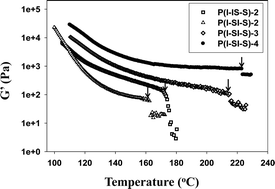We report a synthetic strategy that allows us to manipulate the interfacial region between blocks and control ordering transitions in poly(isoprene-b-styrene) [P(I-S)] block copolymers. This interfacial modification is accomplished by combining a semi-batch feed with anionic polymerization techniques. Using this approach, we are able to control the segmental composition and molecular interactions in our phase-separated block copolymers, independent of molecular weight and block constituents. A library of copolymers is prepared with various interfacial modifications to examine the effect of interfacial composition on copolymer self-assembly. The morphological characteristics of the self-assembled structures are investigated using small-angle X-ray scattering (SAXS), transmission electron microscopy (TEM), and dynamic mechanical analysis (DMA). Normal and inverse tapered block copolymers, containing approximately 15–35 vol% tapered material, show a measurable decrease in the order–disorder transition temperature (TODT) relative to the corresponding non-tapered diblock copolymers, with the inverse tapered materials showing the greatest deviation in TODT. Additionally, TODT was inversely related to the volume fraction of the tapered region in both normal and inverse tapered copolymer materials.

You have access to this article
 Please wait while we load your content...
Something went wrong. Try again?
Please wait while we load your content...
Something went wrong. Try again?


 Please wait while we load your content...
Please wait while we load your content...